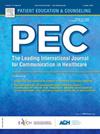Clinicians’ use of metaphoric language in conversations with families of critically ill patients in the intensive care unit
IF 2.9
2区 医学
Q2 PUBLIC, ENVIRONMENTAL & OCCUPATIONAL HEALTH
引用次数: 0
Abstract
Objectives
During conversations with families of critically ill patients in intensive care units (ICUs), clinicians’ metaphoric language use may facilitate families’ understanding, but also has potential drawbacks. We sought to obtain insights regarding how ICU clinicians use metaphors regarding patients’ disease and treatment trajectory.
Methods
We identified clinicians’ metaphor use in N=101 audio-recorded neonatal, pediatric, and adult ICU family conversations about life-sustaining treatments. Using qualitative content analyses, each metaphor’s semantic domain, disease phase, and dialogical function were coded. Overarching themes and patterns were analyzed.
Results
Journey metaphors (N = 140 in N = 54 conversations) most frequently referred to the semantic domains boundary, path and bridge. Although most functioned to convey clinical information (72 %), metaphors were mainly presented in an emotionally charged way, serving to manage families’ perceptions. As patients’ conditions deteriorated, metaphors more often functioned to prepare families for medical limits. Metaphors were sometimes potentially unclear. Others suggested high patient agency, starkly contrasting with patients’ unconscious state.
Conclusions
Metaphors related to ICU patients’ disease and treatment trajectory are common. They may clarify information or strengthen clinicians’ arguments but can also cause confusion and thereby hinder decision-making.
Practice implications
Enhancing clinicians’ awareness about their metaphor use may promote more effective information exchange and decision-making.
临床医生在重症监护病房与危重病人家属对话时使用隐喻语言
在与重症监护病房(icu)危重患者家属的对话中,临床医生使用隐喻语言可能有助于家属的理解,但也有潜在的缺点。我们试图获得关于ICU临床医生如何使用关于患者疾病和治疗轨迹的隐喻的见解。方法我们在N=101个新生儿、儿童和成人ICU家庭关于维持生命治疗的对话录音中识别临床医生的隐喻使用。通过定性的内容分析,对每个隐喻的语义域、疾病阶段和对话功能进行编码。分析了总体主题和模式。结果旅程隐喻(N = 54次对话中N = 140次)最常涉及语义域边界、路径和桥梁。虽然大多数的功能是传达临床信息(72% %),但隐喻主要以一种充满情感的方式呈现,用于管理家庭的看法。随着病人病情的恶化,隐喻的作用更多的是让家属做好接受医疗限制的准备。隐喻有时可能是不明确的。其他人则认为患者能动性高,与患者的无意识状态形成鲜明对比。结论与ICU患者病情及治疗轨迹相关的隐喻较为常见。它们可能澄清信息或加强临床医生的论点,但也可能造成混乱,从而阻碍决策。实践启示:提高临床医生对隐喻使用的认识可以促进更有效的信息交流和决策。
本文章由计算机程序翻译,如有差异,请以英文原文为准。
求助全文
约1分钟内获得全文
求助全文
来源期刊

Patient Education and Counseling
医学-公共卫生、环境卫生与职业卫生
CiteScore
5.60
自引率
11.40%
发文量
384
审稿时长
46 days
期刊介绍:
Patient Education and Counseling is an interdisciplinary, international journal for patient education and health promotion researchers, managers and clinicians. The journal seeks to explore and elucidate the educational, counseling and communication models in health care. Its aim is to provide a forum for fundamental as well as applied research, and to promote the study of organizational issues involved with the delivery of patient education, counseling, health promotion services and training models in improving communication between providers and patients.
 求助内容:
求助内容: 应助结果提醒方式:
应助结果提醒方式:


